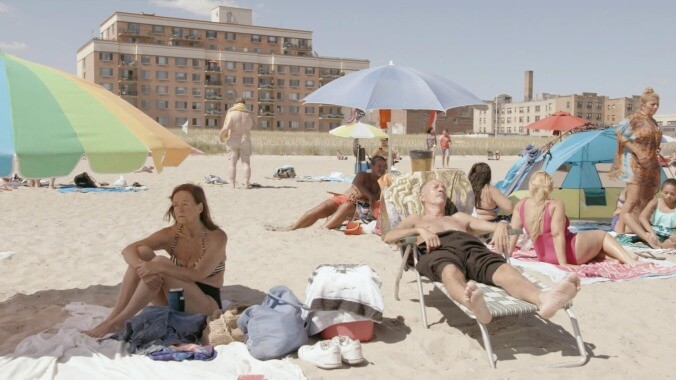“How do you feel about the future?” Throughout Brett Story’s loosely structured documentary The Hottest August, some variation of this question is posed to a large variety of New Yorkers: at the beach, at the bar, on the street, in the studio. The answers, even from the most garrulous interviewees, are mostly pessimistic: The city isn’t what it used to be, the prospects are dim, the environment is getting worse.
Story, who previously directed The Prison In Twelve Landscapes, a documentary about the effects of mass incarceration, shot the film in August of 2017, and in some respects, it already feels like a time capsule of an earlier era of national fatigue. But though the filmmaker makes no attempt to conceal her own concerns (chief among them climate and capitalism), her latest rarely sticks to an agenda. Despite a certain formal rigor, which includes a preference for static wide shots over doc-standard handheld camerawork, the film leaves plenty of room for curiosity and for an outsider’s appreciation for American oddity. (Story, who is only heard from off-camera, is Canadian, a fact that she occasionally mentions to interview subjects.)
Among the interviewees (not all of whom appear to have been simply picked off the street), we meet an osprey conservationist, an economist, a proponent of “robot communism,” and an artist who walks around in a handmade “afronaut” space suit. Sometimes, the environment does most of the talking. In one sequence, Story and her small crew head off to the Jazz Age Lawn Party, a 1910s- and ’20s-themed festival held at Governors Island that basically looks like a flapper Ren Faire. In another, they visit a “rage room” where people pay money to smash furniture and office equipment with baseball bats. Later, they drop in on a “bystander training” class, where students (overwhelmingly women) learn how to intervene on behalf of strangers in uncomfortable social situations.
That these subjects are meant to demonstrate our ambivalence about the modern world is obvious; elsewhere, a scene captures the violence of the Unite The Right rally in Charlottesville (which occurred during the filming of The Hottest August) playing on TV to the indifferent audience of a laundromat. But despite such detours into heavy-handed symbolism, a large part of Story’s roster of interviewees consists of exactly the kind of people who are likely to talk at length to a stranger with a camera on a summer day: stoned teenage skateboarders, drunk college students, and various middle-aged, working-class white people who feel the need to preface their answers by explaining that they are not, in fact, racist.
Overall, the concept recalls (and was almost certainly inspired by) the ambitious documentary experiments of the early 1960s, most obviously Edgar Morin and Jean Rouch’s Chronicle Of A Summer and Chris Marker and Pierre Lhomme’s Le Joli Mai. (Story’s periodic use of narration read by an actor is also reminiscent of Marker and of Jean-Marie Straub and Danièle Huillet, the proponents of the dialectical materialist landscape film; the text includes quotations from Karl Marx’s Capital and from essays by Annie Dillard and Zadie Smith.) Yet one can’t help but wonder whether these mid-century influences can really offer an insightful approach to our own, very different time. Morin and Rouch’s self-reflexive cinéma vérité, with its underlying questions of truth, wasn’t formulated in a world of social media that appears to give instant access to the lives and opinions of strangers.
Story is likely more than aware of these problems, as well as that Big Issue of documentaries—that they do not capture so much as construct the truth. While it never feels completely defeatist, her film offers scattered snapshots of an uncertain society in its dog days.









































